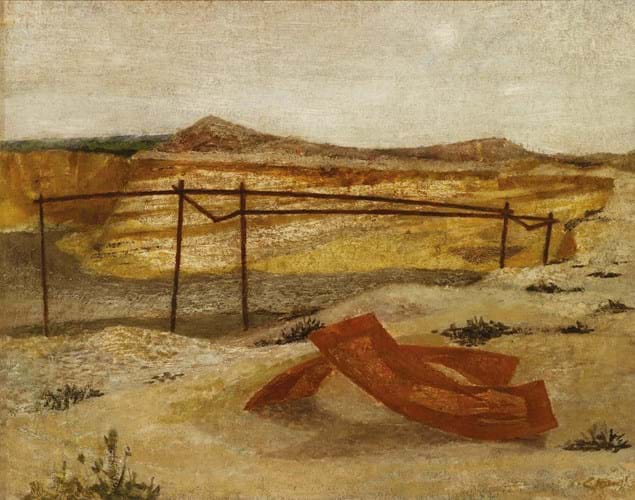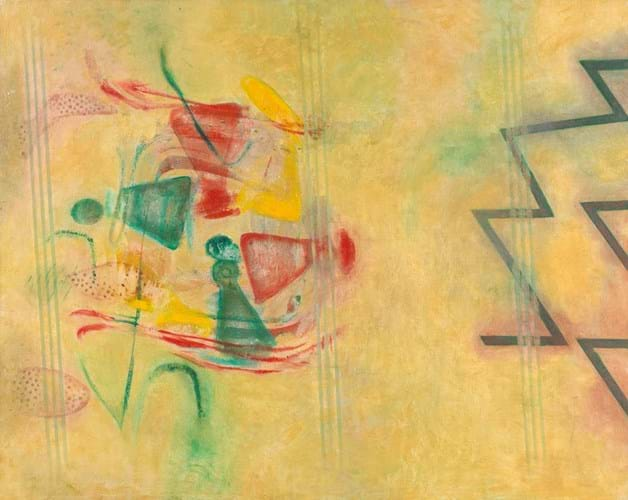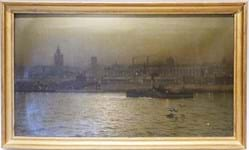
Six years after it held a large retrospective of the work of Prunella Clough (1919-99), London gallery Osborne Samuel is back with another dedicated show.
Pushing Stones Up Hills, which is currently online with an in-person show scheduled from April 12 at the gallery’s space in Mayfair, explores Clough’s life and approach to her work through 20 paintings dating from the late 1940s to the mid-1990s.
The show’s title refers to a comment Clough made on the challenges of painting and composition.
Regarded as an influential artist and teacher to the post-war generation, she spent a long artistic career conveying the industrial and man-made.
“Clough’s painting helps us see afresh, to reconsider the world around us and to take delight in the poetry of the mundane and the overlooked,” says the gallery’s Gordon Samuel.
“Pru, as we knew her, had a highly perceptive, peripheral vision as well as a distinctive ability to locate beauty and potential subject matter in all manner of urban detritus.”
Pasmore direction
Born in London, the daughter of a civil servant and a poet, Clough studied at Chelsea School of Art and during the war worked at the Office of War Information as a draughtsman of maps and charts. After the conflict she continued her studies at the Camberwell College of Art under Modern British artist Victor Pasmore.
As Britain rebuilt and regenerated itself in the years following the war, these industrial landscapes – or ‘Urbscapes’ as the artist herself described them – became the overriding presence in her oeuvre. Thameside cranes, lorries on inner city building sites and workers in factories featured on Clough’s canvases.
Later in her career, she became focused on Abstraction, though her works retained a figurative base and an affiliation with waste and detritus.
Throughout her life she famously kept prices of her art low – she once held a jumble sale of her paintings – but as her star has risen in the decades since her death so has the price tag. As with many Mod Brit painters, the most sought-after paintings date from the 1940s and early 1950s.

'Oblique 1' (1978) by Prunella Clough, 2ft 5in x 2ft 5in (76 x 76cm) oil on canvas – £38,000 from Osborne Samuel.
“A good example of the value of these early, figurative paintings, loosely labelled Neo-Romantic works, can be found in a painting I tried for many years to buy from the collector Allen Freer titled Still Life with Yellow Marrows, 1948,” says Samuel.
“The painting was sold at Christie’s in January 2020 at the sale of The Delighted Eye: Works from the Collection of Allen and Beryl Freer, just prior to the onset of Covid-19. It was estimated at £18,000-25,000 and I didn’t get a bid in; it realised £47,500.”
Helping curate the exhibition at Osborne Samuel is Gerard Hastings, a friend of Clough and an expert on the work of Keith Vaughan.
“His objective is to help explain the relationship between her imagery and the kinds of visual sources that informed and inspired it – decaying walls, flaking paint, discarded concrete with metal reinforcement protruding, rusted and abandoned machinery, electrical circuit boards and market stalls on the North End Road, near her home in Fulham,” says Samuel.

'Chinese Chequers' (1989) by Prunella Clough, 3ft 4in x 4ft 2in (1.01 x 1.27m) oil on canvas – £38,000 from the 'Pushing Stones Up Hills' exhibition at Osborne Samuel.
Art with a twist
One of the earliest works in the exhibition is Deserted Gravel Pit (c.1946), which was shown at Clough’s first show at the Leger Galleries in 1947. This abandoned landscape marks both the artist’s move away from beachscapes towards her trademark man-made environments and the importance of geometric configurations in her compositions, as seen by the remnants of broken scaffolding and twisted metal.
Shapes derived from factory-made materials are also brought to the fore in Industrial Interior 4 (1959) which merges together pieces of piping, tubing, taps, stopcocks and valves.
Later works, such as Chinese Chequers (1989), were inspired by the myriad of objects Clough saw being traded at North End Road market in Fulham. Cord 2 (1995), another late piece, is part of a series of collages and paintings made with string, rope, cord and even typewriter ribbons.














